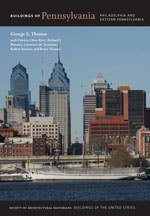
One of Lancaster County's most visible landmarks is the Grubb House that has been revived as the setting for the Pennsylvania Renaissance Faire, an only in America conflation of medieval pageantry and modern showbiz. On winter days, when the grounds are not full of cars, the house is clearly visible from the Pennsylvania Turnpike (I-76), just east of the Lebanon exit. Like so many other mansions associated with the iron industry, from the early houses for the Lukens family ( CH26) to the Coleman houses ( LE3, LE6) in Lebanon County, it shows evidence of a high degree of specialization in the various outbuildings that represent the numerous roles of the ironmaster. The main house was begun c. 1800 and, like most of its type, it is a five-bay house, here built of the local iron-tinted sandstone. Visible from the road is the mansarded tower with iron roof cresting that is probably a post–Civil War updating, perhaps during the ownership of Alfred Grubb. The family is of note in bringing together the diverse strands of the Shippen and Burd families of Philadelphia as well as the Brooke family of Birdsboro (Berks County), a lineage that spanned the region's economic evolution from maritime to iron.

